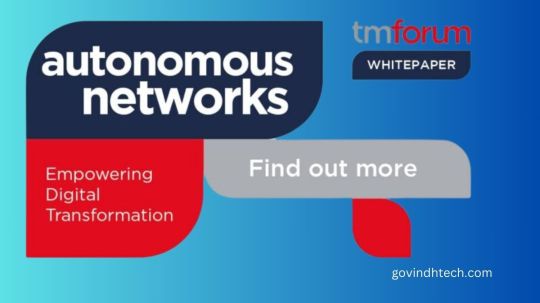#ibn
Text
Da ne želiš da mi daš ono što tražim i priželjkujem iz Tvoje riznice, ne bi me nadahnuo da tražim.
Ibn Kajjim el-Dževzijje, Bolest i lijek
17 notes
·
View notes
Text
Harnessing AI for Autonomous Network Operations

Autonomous network system
Technologies like 5G, IoT, cloud computing, and AI are revitalizing the telecommunications sector, which is vital to global connectivity. Consequently, networks have gotten harder to maintain. Automation is required to manage repetitive tasks, keep an eye on the health of the network, and react quickly to problems. But the communication service providers’ (CSPs’) current skill sets might not match the changing needs of this changing environment.
CSPs need adaptable teams to thrive in the modern era: software developers for automation through vendor application programming interfaces (API), data scientists for data interpretation and operations, and service assurance engineers for creating closed loops to guarantee service reliability.
By assembling teams with a variety of backgrounds, Communication Service Providers not only close the gap but also gain from noteworthy developments in a related field. With the advent of generative AI, programming languages have progressed toward low-code/no-code paradigms. Today, foundational models are able to produce formal code from natural language descriptions of tasks. The notion of intent-based networking (IBN) gained a fresh viewpoint as a result.
In intent based networking, human administrators articulate high-level network goals using natural language, or “intents,” and their intentions are automatically converted into network configurations and policies. In addition to potentially changing the game in terms of closing the talent gap within telcos, intent based networking has the ability to enhance network management. Furthermore, as network conditions change, autonomous networks (AN) claim to be able to use intents as inputs to automatically self-configure, self-optimize, and self-heal networks.
Even though both intent based networking and Autonomous Network have bright futures ahead of them, ongoing questions remain regarding their viability and program applications, including intent expression, precise translation into network configuration, system complexity, transparency, and other issues. In this blog, we explore the domains in which their real-world implementation has the potential and examine the obstacles that might arise.
An example of motivation: launching new services with no intention of
In order to comprehend the necessity of optimizing communication between CSP teams and the network, let’s examine the example of a new service deployment.
It is assumed that the Communication Service Providers network operates automatically in accordance with the guidelines provided in the TMF Introductory Guide 1230 (IG1230) on the Technical Architecture of Autonomous Networks. Within that framework, the CSP’s OSS consists of the following:
(1) An orchestrator for automated provisioning, testing, and service provisioning.
(2) An assurance system with network inventory that gathers information, generates insights about the state of the network, and thus enables data-driven decision making within the framework of closed-loop control.
(3) A policy manager that directs network behavior based on predefined policies, guaranteeing compliance with the wider Communication Service Providers policies.
To put it briefly, automated operations involve tightly coupling services with the TOSCA service descriptors, configurations, policies, and imperative workflows that are assigned to them by humans. During the design phase, service designers add intelligence and decision-making to these workflows. Zero-touch experience is achieved as long as future conditions have been anticipated and policies have been put in place to handle them. Service designers must proactively anticipate a wide range of conditions that may arise in the network and provide detailed instructions on how they must be addressed.
For the various stages of the service lifecycle-service design, service instantiation, and service assurance, respectively-IBM refer to them as Day 0, Day 1, and Day 2.
The creation of diverse service assets is included in service design, as shown in Figure 1. The service design team is responsible for this; they must create the necessary workflows and scripts and comprehend the Day 1 and Day 2 operations of the service. Figure 2’s red lines show how a new service is provisioned, making it possible for orders to be placed for the service.
After a subscriber requests a service, the service is instantiated when the service order is received. The service order manager (SOM) normally sends the service order to Communication Service Providers these days via the TMF 641 interface. Upon receipt of the service order, the service orchestrator guarantees the execution of the workflows and the deployment and operation of the requested monitoring configurations, PM/FM models, and policies. In Figure 2, the service instantiation is displayed using green lines.
The closed-loop methodology of service assurance involves automated lifecycle actions and constant monitoring of deployed services’ conditions. In Figure 2, the assurance closed loop is displayed using blue lines.
To sum up, a significant amount of manual labor is required during the design phase because the network needs to be provided with instructions for the new service.
What do intentions mean?
The term “intents” in intent based networking refers to the broad goals that Communication Service Providers hopes to accomplish within its network. As previously mentioned, the engineering teams express the objectives with intents, and the logic underlying the intents translates them into the necessary network configuration that fulfills the intent objective. This eliminates the need for the engineering teams to deal with intricate low-level network configurations during Day 0 operations.
After the configurations are applied to the network, the Autonomous Network keeps an eye on the services that have been deployed and modifies the configuration as needed to keep the operation in line with the intended goals. The use of intents is expanded into Day 2 operations by the Autonomous Network .
Views from Autonomous Network and Intent Based Networking
Next, IBM list a few areas where intents might potentially transform pre-intent established practices into revolutionary ones:
Day 0 Operations: Setting up new services – Use generative AI to process natural language input and add requirements on its own.
Launch of fresh services Use natural language to describe new services, e.g., “offer a tailored connectivity solution for secure communication within healthcare institutions” or “enable IoT device communication across smart city infrastructure.” Then, use generative AI to generate the required service assets automatically.
Automated creation of resource drivers tailored to individual vendors Based on vendor documentation, use generative AI to create resource drivers unique to each vendor.
Day 1 Operations: Streamlining the service order process so that users can make requests in plain English. A unique service ordering experience, like mixing and matching products from the catalog, is made possible by this user-friendly approach.
Feasibility checks: These efficiently evaluate important factors, such as the availability of fiber optic lines, and expedite validation checks as customers express their intents. As a result, network engineers have less work to do, services are validated more quickly, and deployment is more responsive and agile.
Day 2 Operations: Dynamic service assurance allows networks to adapt to changing circumstances and user demands with intelligence. Intent-based policies that are flexible improve agility and guarantee the responsiveness and dependability of network services in real time.
The difficulties with Autonomous Network and intent based networking
There are two primary issues that need to be resolved:
How do you communicate and express intent?
What does the intent handler look like and how can I execute on an intent?
The TMF921 Intent-based Networking API was unveiled by TM Forum and provides a structured framework for specifying high-level network intents.
The intent is defined by TM Forum as follows:
“A technical system’s intent is the formal specification of all expectations, including requirements, goals, and constraints.” To fully utilize the intent concept, network engineers would need to become familiar with this formal language, which is why the part formal specification raises concerns. Furthermore, formal specifications do not always result in fewer parameters needing to be supplied with them. This feature calls into question the expected simplification of network administration that is commonly associated with intent based networking.
Moreover, the intent handler-the central part of intent based networking that contains the reasoning for intent interpretation-becomes nothing more than a deterministic interpreter of the intent formal language as a result of formalizing the intent specification. The issue is how to transform the intent handler into a declarative, autonomous system so that people don’t have to predict every possible network situation and give detailed instructions on how to fix it. If not, the automated to autonomous system operation transition cannot be accomplished.
Read more on Govindhtech.com
#AI#AutonomousNetworkOperations#Autonomousnetworksystem#IBN#IBM#generativeAI#IoTdevice#networkintents#TMForum#technews#technology#govindhtech
0 notes
Text


#AfDBPT23 2* Text to Image API | DeepAI #text2img #Gabby
#stablediffusion #craiyon-V3 #dalle #dalleMini #lookingglassai
Tonjus Ezzhen au Irzihbn
#deepai#text2img#image#text to image#to#text to#text#api#AfDBPT23#afd#ibn#stablediffusion#stable diffusion#dalle#dallemini#craiyon#gabby#Toni#tonis#tonjus#essen#ezzhen#au#auf#Irzihbn#rädern
0 notes
Quote
When proven wrong, the wise man will correct himself and the ignorant will keep arguing.
Ali ibn Abi Talib
#Ali ibn Abi Talib#motivation#quotes#poetry#literature#relationship quotes#writing#original#words#love#relationship#thoughts#lit#prose#spilled ink#inspiring quotes#life quotes#quoteoftheday#love quotes#poem#aesthetic
3K notes
·
View notes
Text
Israeli Occupation Force sent an undercover team (dressed in women, doctors and civilian clothing) to storm the Ibn Sina Hospital in Jenin (West Bank) and carry out the assassination of three Palestinian’s.
youtube


#free palestine#palestine#jenin#west bank#ibn sina#gaza#free gaza#iof terrorism#iof#israel#fuck israel#fuck the iof
3K notes
·
View notes
Text


Ibn Battuta was a 14th century traveller who wrote the Riḥlah, one of the most famous travelogues ever
#yemen#jerusalem#tel aviv#current events#palestine#free palestine#gaza#free gaza#news on gaza#palestine news#news update#war news#war on gaza#Ibn battuta#History#Travel
2K notes
·
View notes
Text

Anthony Fineran (B 1981), Ibn Jacob Flag Sutton, 2022
0 notes
Text

alty & malik
#assassins creed#digital painting#digital illustration#illustration#altair#malik al sayf#altair ibn la'ahad
10K notes
·
View notes
Text
Tingkatkan mutu pelayanan, Puluhan Personel Polres Pringsewu Ikuti Pelatihan
Tingkatkan mutu pelayanan, Puluhan Personel Polres Pringsewu Ikuti Pelatihan
LAMPUNG7COM | Polres Pringsewu Polda Lampung menggelar pelatihan peningkatan kemampuan Pelayanan Publik dan Membuat konten media sosial. Rabu (9/11/22).
Pelatihan yang berlangsung di aula Mapolres setempat itu dibuka oleh Kapolres Pringsewu AKBP Rio Cahyowidi yang diwakili Kabag SDM Kompol Efendi Koto, SH dengan menghadirkan dua narasumber dari institut Bhakti Nusantara (IBN) Pringsewu dan…

View On WordPress
0 notes
Text

Little more than shadows WIP
2K notes
·
View notes
Text
Kome se omogući da učini dovu, njemu će ta dova biti primljena, jer Uzvišeni Allah kaže: "Zovite Me, i Ja ću se, zaista, odazvati" (Gafir, 60); "A kada te robovi Moji za Mene upitaju, Ja sam, sigurno, blizu..." (El-Beqare, 186).
Ibn Kajjim el-Dževzijje, Bolest i lijek
7 notes
·
View notes
Text
What is the core component of intent-based networking?

What is Intent-based networking?
An emerging technology concept called intent-based networking (IBN) seeks to replace the manual processes of configuring networks and responding to issues with a deeper level of intelligence and intended state. Rather, network administrators specify a desired result or corporate aim, also known as the “intent,” and the network’s software uses artificial intelligence and machine learning to determine how to get there.
Intent-based networking (IBN) systems anticipate possible deviations from a given intent and recommend the necessary action to ensure that intent, in addition to automating time-consuming tasks and providing real-time visibility into a network’s activity to validate that intent. The increased intelligence decreases errors and increases the network’s speed and agility.
Intent- based networking’s benefits
Compared to software-defined networking and even regular networking, intent-based networking has a few definite advantages. The majority of these benefits result in substantial time savings:
Elimination of manual labor: An intent-based network converts instructions into actions. Network configuration does not need to be done by a network administrator in order to accommodate new requirements or policies. The network thinks for itself, confirming that a configuration will function, presenting options to the administrator, and implementing the necessary adjustments to conform to the intended configuration. Without assistance from a human, the intent-based network is also capable of provisioning and repairing itself.
Quicker troubleshooting and fix: An intent-based network quickly detects performance problems because it is always monitoring itself. These problems are also resolved by the intent-based network, which applies machine learning to identify and apply the optimal solution.
Decreased risk of noncompliance: An additional benefit of having a network that continuously checks and fixes problems is that the network adheres to any rules that the network administrator has established.
Increased security The intent-based network continuously monitors traffic, including encrypted traffic, to look for threats. Vulnerabilities in security are quickly found and fixed.
Optimized analytics: Network managers are able to make better decisions that lead to better business outcomes when they have a clear understanding of how a network is operating. Constantly collecting information about itself, an intent-based network can be examined in a variety of ways to learn important details about security risks, network performance, and other topics.
Quick translation of high-level business goals into the best network configurations to support them: This is the main distinction between an intent-based network and a software-defined network. An intent-based network does this instantly. The time spent on planning, testing, and manual configuration is greatly reduced when a network administrator can swiftly examine and select from approved configuration options. A faster time to business goals means a larger return on investment.
What does intent-based networking aim to achieve?
From start-ups to well-known networking vendors, intent-based networking companies provide a variety of options with minor variations. However, networking that makes use of cognitive computing and machine learning is the aim in order to enable more automation and reduce the amount of time spent on manual configuration and management. They offer software that converts network configuration into intent. With intent-based networking, network administrators specify a desired result or corporate aim (the intent), and the network’s software uses artificial intelligence and machine learning to determine how to get there.
Intent-based networking systems anticipate possible deviations from a given intent and recommend the necessary action to ensure that intent, in addition to automating time-consuming tasks and providing real-time visibility into a network’s activity to validate that intent. The network becomes more error-free, quicker, and more nimble thanks to this increased intelligence. The fundamental feature of intent-based networking is its capacity for self-monitoring and self-correction.
How does networking based on intent operate?
Artificial intelligence and machine learning are used by intent-based networking to prescribe and carry out routine tasks, establish policies, react to system events, and confirm that objectives and actions have been met. For instance, if it’s necessary to accomplish a particular goal, it can enable servers to be reached from particular networks. In addition to configuring network changes, the system can also verify that they are being carried out and make any necessary adjustments. Intent-based networking, which is seen as a development of software-defined networking (SDN), expands on that technology by allowing a higher degree of intelligence to specify which tasks should be automated.
What connection exists between SDN and intent-based networking?
Compare intent-based networking to software-defined networking as a more advanced version of SDN. Software-defined networking provides a single dashboard for network infrastructure management. It makes it possible to automate a number of laborious tasks, such as setting up and growing a network. In addition, it makes it simple and quick for a network administrator to adjust the network’s configuration in response to the requirement to support a particular task or application. It provides network administrators with a comprehensive picture of the network as a whole, showing them how its various components interact to either improve or worsen network performance.
Software-defined networking is enhanced by intent-based networking. It enables a network administrator to set up a system so that it can support and handle a business case rather than just one particular job. Based on pre-deployed policies, the intent-based network can determine how to achieve the administrator’s goals while upholding existing ones. In order to make sure the network is still functioning as intended, an intent-based network constantly self-checks as it evolves. The network can propose changes for the operator to consider and approve if a fix is required.
Read more on Govindhtech.com
#intentbasednetworking#artificialintelligence#machinelearning#IBN#SDN#Software#technews#technology#govindhtech
0 notes
Text

It's an honor to be commissioned by the one game Assassin's Creed I love till eternity, and I'm thrilled to show my art to celebrate the launch of AC Mirage. Thank you so much!
We now follow in the eagle's path.
1K notes
·
View notes
Text

anatomy of an assassin
#(shakily hands you altair)#vent art from the really shit nightmares ive been having lately#its supposed to represent how derealisation feels like—when you just wake up from a nightmare#and nothing feels real. your body is not yours. putting on clothes is like putting on your own skin again until you feel Normal#dont look at my open tabs of middle eastern clothing. ihad an autism moment there for pseudo-accuracy sake#inhuman altair feels again ig. will you ever be comfortable in your own skin? (the answer is perhaps never)#my art#asscreed#assassins creed 1#assassin's creed 1#assassins creed#assassin's creed#ac#ac1#altair ibn la'ahad#altaïr ibn la'ahad
702 notes
·
View notes
Text
Where Would I Be Without IBM?

Funny thing. To spell out "an IBM Machine" is to say "an International Business Machines Machine". I do believe, though my cursory search engine search is not getting such results, in a change made at some point three decadesnor so back, that IBM actually officially stands for nothing -- it is just three letters. Mayne there is a metaphor in that -- I do not know.
The word "computer" apparently does not spring to mind in 1962. Had it, we could have solved that redundancy problem -- so now it would be an IBM Computer, a computer as so understood in 1962 -- fills a room, uses punchcards. This makes that change to IBN all the more perplexing -- because had they dropped that change in the first place, that two would solve the two machines rubbing against each other trouble.

1 note
·
View note
Photo

History Births on September 01
0 notes